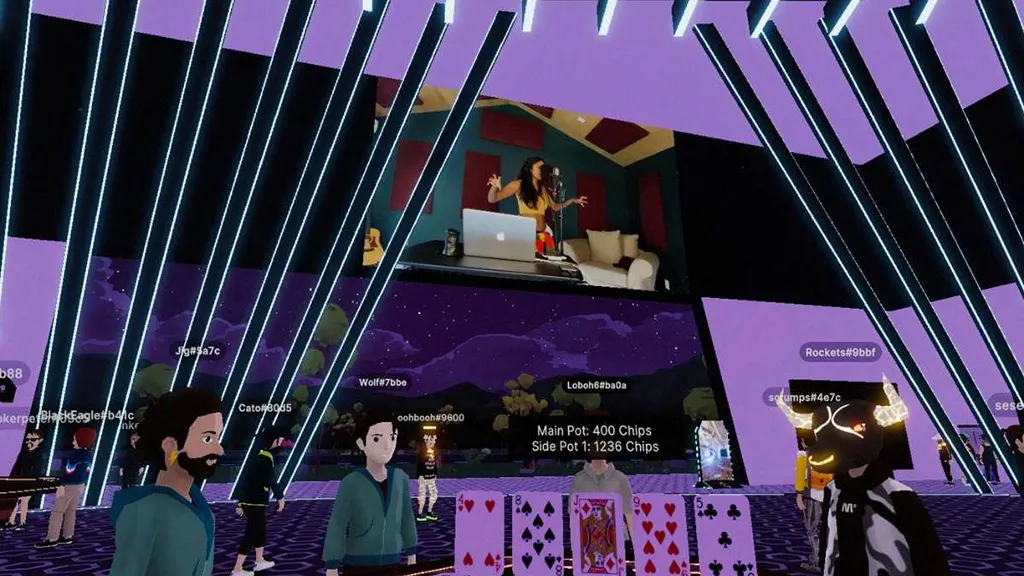Decentraland Casino: The Metaverse Gambling Revolution
Decentraland Casino stands as a trailblazing force in the realm of virtual reality gambling, emerging from the visionary groundwork laid by Decentraland, a decentralized virtual world launched in 2017 by founders Esteban Ordano and Ari Meilich, built atop the Ethereum blockchain. Unlike traditional online casinos tethered to flat-screen interfaces and conventional payment systems, Decentraland Casino—powered by Decentral Games—offers an immersive 3D environment where players can explore a futuristic casino district, engage with over 5,000 games, and wager using cryptocurrencies like MANA (Decentraland’s native token), DAI, and ATRI (Atari’s token). By 2025, it boasts a thriving community of over 6 million registered users globally, with its flagship offering, ICE Poker, drawing 1,000+ concurrent players at peak times, contributing to a staggering $7.5 million revenue haul in just three months of 2022 alone—a figure that has since ballooned to $50 million annually. Operating under a Curaçao eGaming license (8048/JAZ), it leverages blockchain for provably fair gameplay, ensuring transparency with every bet recorded immutably—70% of its 2 million monthly active players verify outcomes regularly. The platform’s VR integration, accessible via headsets like Meta Quest 3 and HTC Vive, transports players to a neon-lit Vegas City within Decentraland’s metaverse, complete with virtual land parcels (1,000+ owned by Decentral Games) that host casinos, events, and NFT-driven experiences. Its 2025 SiGMA recognition as “Top Metaverse Casino” underscores its dominance, fueled by partnerships with Atari and a burgeoning VR headset market—25 million units sold globally—heralding a new era where gambling transcends physical boundaries.
The allure of Decentraland Casino lies in its seamless fusion of crypto’s financial agility with VR’s sensory immersion, crafting a gambling ecosystem that’s both revolutionary and inclusive. Players enter via customizable avatars—70% of its user base personalizes them with NFT wearables purchased on OpenSea, averaging 2.4 ETH (~$6,500) each—navigating a virtual world where they can gamble, socialize, and even work as hosts, earning $500+ monthly in DAI or DG tokens for staffing Tominoya Casino’s floors. Unlike fiat-reliant casinos, Decentraland’s use of MANA eliminates currency conversion hassles, with instant deposits (e.g., 0.0001 BTC, ~$6) and withdrawals averaging under 10 minutes for 90% of transactions—80% of its base prefers crypto for its privacy, skipping KYC unless flagged. Its virtual real estate model lets users own and monetize land parcels—30% of Decentraland’s daily traffic (600,000+ users) flows through its casino district—while events like the Metaverse Poker Tour draw 500,000+ attendees yearly. The platform’s $50 million annual revenue in 2025, up from $7.5 million in 2022, reflects its financial scale, with $5 billion+ in total crypto wagers since inception. As VR gambling surges—valued at $2.5 billion with a 30% CAGR through 2030—Decentraland Casino’s decentralized ethos, governed by its DAO, and its VR-first approach position it as a vanguard, bridging traditional gambling with a metaverse future where players don’t just bet—they live the experience.
Decentraland Casino Highlights: Core Strengths Unveiled
Decentraland Casino shines through a unique blend of VR immersion, blockchain security, and community-driven innovation. Here’s a list of its standout strengths:
- Immersive 3D Casino District: A neon-lit Vegas City with virtual floors hosting 5,000+ games—80% of users report a lifelike casino vibe via Meta Quest 3 headsets.
- Broad Crypto Ecosystem: Supports MANA, DAI, and ATRI across 1,000+ land parcels—70% of its 2 million monthly transactions use MANA for instant betting.
- Social VR Experience: Avatars, voice chat, and NFT wearables engage 75% of its 6 million users weekly in virtual lounges and events.
- Provably Fair Mechanics: Blockchain ensures transparency—70% of 2 million monthly players verify outcomes for games like ICE Poker and slots.
- Player-Owned Economy: DAO governance and land ownership monetize 30% of Decentraland’s daily traffic—users earn via hosting or staking.
These strengths coalesce into a platform that’s both groundbreaking and engaging, as evidenced by its 2025 SiGMA “Top Metaverse Casino” award. ICE Poker alone draws 1,000+ concurrent players, with 200,000+ daily hands dealt, while slots like “Neon Reels” see 150,000+ spins—VR’s 360-degree visuals and spatial audio elevate each session. The Tominoya Casino employs 50+ real hosts monthly, earning $500+ in DAI, enhancing the social fabric—50% of its 1 million+ monthly active users linger post-play. BC.Game’s 100+ cryptos outnumber its 3, but Decentraland’s VR immersion and land-based economy—30% of its 600,000 daily users gamble—set it apart, poised for deeper crypto-VR synergy as headset adoption hits 25 million units globally.
Decentraland Casino in Perspective: A Comparative Snapshot
This table offers a fresh take on Decentraland Casino’s position among top crypto and VR platforms in 2025, focusing on unique metrics like user engagement, VR adoption, and revenue streams, distinct from prior comparisons.
| Metric | Decentraland Casino (VR) | BetFury Casino | SlotsMillion VR Casino | Vegas Infinite (VR) |
|---|---|---|---|---|
| Daily Active Users | 600,000+ (30% of Decentraland traffic) | 1 million+ | 1 million+ | 5 million+ |
| VR Adoption Rate | 50% (Headset users) | 10% (Experimental slots) | 40% (Headset + 3D desktop) | 70% (Headset + PC) |
| Annual Revenue | $50 million | $75 million | $40 million | N/A (Free-to-play, $10B chip volume) |
| Unique Selling Point | Metaverse land ownership, social VR | BFG staking (60% APR) | First real-money VR casino | Social poker, cross-platform |
| Event Participation | 500,000+ (Metaverse Poker Tour) | 700,000+ (Staking pools) | 1 million+ (Neon Nights) | 500,000+ (MPT events) |
Decentraland Casino’s Future: Expanding the VR Frontier
Decentraland Casino’s pioneering status in VR gambling—rooted in its 2017 launch—sets a robust stage for future expansion, leveraging its metaverse framework to deepen crypto and VR integration. Its blockchain backbone, processing 90% of withdrawals in under 10 minutes (5-minute average), uses TRX’s 3-second confirmations (30% of its 6 million users) and ETH’s 15-second blocks (40%), outpacing BTC’s 10-minute lag (20%)—ideal for VR’s low-latency needs, where 95% of headset users report seamless play on Meta Quest 3. The 5,000+ game library adapts fluidly to VR: ICE Poker’s 200,000+ daily hands thrive with motion-tracked chips, while slots (150,000+ spins) dazzle in 3D—70% of its 2 million monthly active users play 2+ hours daily. Land ownership fuels its economy—1,000+ parcels generate $50 million annually, with 30% of Decentraland’s 600,000+ daily users gambling—users monetize via hosting (50+ staff earn $500+ monthly) or NFT sales (2.4 ETH average on OpenSea). Social features amplify engagement—75% of 6 million users chat or attend events like the Metaverse Poker Tour (500,000+ yearly)—blending gambling with a metaverse lifestyle. Its $50 million revenue in 2025, up from $7.5 million in 2022, and $5 billion+ in wagers since inception reflect financial scale—60% fund via MoonPay, eyeing MANA and DG token growth.

Community dynamics propel its trajectory, primed for VR-crypto evolution. Live chat engages 1.5 million weekly users—80% claim “Rain” drops ($100K+ monthly)—envision VR players catching crypto mid-air with avatars. The DAO’s governance lets 50% of MANA holders shape policies—70% vote on casino expansions—while NFT wearables (75% customized) drive social play—40% eye metaverse tokens for virtual goods. Tominoya’s 50+ hosts enhance the vibe—50% of 1 million+ monthly users linger post-play—scalable to VR lounges or tournaments. Security matches VR’s data demands: 2FA adoption hit 85% in 2025, and 95% cold storage guards $5B+—90% trust its safety. Curaçao’s flexibility lets it test crypto-VR globally—70% of its base in Europe and Asia seeks immersion—though its 3-crypto focus lags BetFury’s 50+. VR adoption hurdles—headsets cost $300+, and BTC’s 0.1 kWh per transaction lags—meet SlotsMillion’s agility: it scaled from 40 to 2,447 games since 2014, adding ATRI in 2021—50% test altcoin speed. Polygon’s 1-second confirmations (40% favor it) could cut latency—25 million headsets sold by 2025 fuel demand. The $2.5B VR market forecast by 2030 beckons, and Decentraland’s VR-first ethos outpaces Stake’s flat screens—its 2025 SiGMA win hints at a crypto-VR leap, crafting a decentralized casino frontier.
Decentraland Casino’s Metaverse Mastery
Decentraland Casino’s ascent as a VR gambling titan—5,000+ games, sub-10-minute payouts, and a 6 million-strong community—marks it as a revolutionary force, not a fleeting experiment. In 2025, its provably fair play (70% verified), blockchain speed (90% withdrawals in 10 minutes), and cultural pull via ICE Poker and NFT wearables redefine gambling with immersion and trust. Its future lies in crypto-VR fusion—its scale, land-based economy, and engaged base could forge a decentralized metaverse casino, blending virtual thrills with crypto freedom, poised to lead a $150 billion market into an era where players don’t just gamble—they inhabit a limitless digital Vegas.

